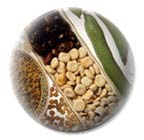- Home
- Introductions

|
Vegetable Seed Production: PrinciplesYou are here: Seed Production: Principles: Environmental Factors Environmental Factors Vegetable crops are harvested for their vegetative (celery, carrot) or reproductive (tomato, broccoli) organs. In most cases, the harvest of the vegetable crop requires environmental conditions that are very different from those required for a seed crop. For example, temperature, photoperiod, length of growing season, and precipitation may vary between vegetable and seed crops. Ambient temperatures have very different effects on vegetables and their end use. Those vegetables that are harvested for market-use such as carrot, onion, radish, brassicas, and lettuce are typically grown in areas with lower temperatures from those required for a seed crop in order to maintain quality vegetative growth, and minimize bolting. Seed production of these same crops often requires higher temperatures to encourage bolting although extremely high temperatures also hinder pollen growth and fertilization, leading to reduced seed number per floret or fruit. This is true in onion, tomato, and lettuce. In contrast, beet and carrot vegetable crops have been selected to avoid bolting in mild climates but they still require adequate periods of cool temperatures (vernalization) for flowering and seed production. The Pacific Northwest of the United States provides such sustained cool temperatures and this is the reason why beet and carrot seed production occurs in this region while market-use production of these crops is geographically more diverse. |